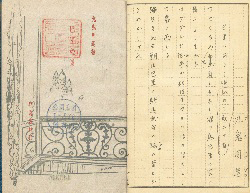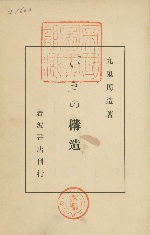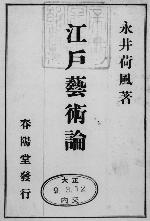![]()
Section 3: KUKI Shuzo - From Paris to Edo
Philosopher KUKI Shuzo (1888-1941) accompanied his wife and studied abroad in Europe from October 1921, and studied under Germany's Heinrich Rickert (1863-1936) and Martin Heidegger (1889-1976) as well as France's Henri Bergson (1859-1941). He stayed in Europe for nearly 7 years until returning to Japan in January of 1929. In the 1920's, Japan's economic standards were comparatively high to those in Europe, which was devastated by the war, and it was a very fortunate time for exchange students. During his stay in Paris, KUKI employed Jean-Paul Sartre (1905-1980), who was still a student at the time, as his personal French language instructor, and a note titled "Mr. Sartre" still remains in the Konan University Kuki Shuzo Library. There is a theory that Sartre was introduced to the phenomenology, which was a new trend in Germany thinking, through KUKI. KUKI was invited to Imperial University of Kyoto and on his trip back to Japan he stopped in Washington to meet with Paul Claudel, who was serving as the ambassador to the United States at the time. After returning to Japan, he lectured on French philosophy.
KUKI Shuzō, Pari shinkei, Kamoshorin, 1942 [911.56-Ku779p] 
From 1925 to 1927, under aliases (S. K., KOMORI Shikazo), KUKI submitted a large number of poems to the 2nd incarnation of Myōjō which was under the supervision of YOSANO Tekkan (1873-1935). During his time as a professor at Imperial University of Kyoto, it's said that he travelled to lectures from the popular entertainment area of geisha establishments Gion in a rickshaw, however he also seemingly acted like a playboy in Paris, and left behind suggestive poems such as "Your blonde hair that you take such care of, reflects the lamplight, what a happy bedroom." and "In the half light of a spring moonlit night, I walk in the shade of an acacia tree, with someone else's wife." After KUKI's death, these poems were compiled in Pari Shinkei (lit. Paris in the mind) by KUKI's friend philosopher AMANO Teiyu and they were published with illustrations by another friend, art historian KOJIMA Kikuo (1887-1950). Regarding KUKI, AMANO states, "Strange as it is, this sharp and precise analyst also has a superb artistic soul". In the essay Nihonshi no ōin (lit. Rhyming of Japanese poems) written in his later years, KUKI includes some of his own poems, written during his time in Paris, as examples in the appendix.
KUKI Shuzō, "Iki" no kōzō, Iwanami shoten, 1930 [609-110] 
This elaborate essay is famous for clarifying the mental structure of the Japanese using a hermeneutics method learned from Heidegger. This work has been translated into French as a leading work of Japanese philosophy. This work analyzes the intrinsic Japanese mental attitude of iki (synonym of chic) in the culture of Edo, and Iki no honshitsu is the model for the draft written in Paris. Another essay written on the voyage back to Japan states, "Living in Europe for 7 years has allowed me to see clearly for the first time the beauty of Japan's culture", and it can be said that his experience in the West drew KUKI to Edo.
KUKI defined iki as "refinement, tension and voluptuousness" and analyzed how it was used in nature and art. He states the whitish brown (discolored) which he wrote about in poem yearning for his mother in Pari shinkei, ("I heard that the whitish brown that my mother liked was currently popular and it made me somehow nostalgic and happy") as a representative example of iki. While pregnant with Shuzo, KUKI's mother Hatsuko (1860-1931) had an affair with OKAKURA Tenshin (1862-1913). His mother suffered mental problems and was interred in a mental institution, but KUKI adored her for his entire life.
NAGAI Kafū, Edo geijutsu ron, Shun’yōdō, 1920 [391-67] 
There was another individual before KUKI who travelled to France and ended up in Edo. NAGAI Kafu (1879-1959) lived in France as an employee of the Lyon branch of the Yokohama Specie Bank from 1907 until the following year, nearly 15 years before KUKI's trip to France, and after returning to Japan he published Furansu Monogatari (lit. French Stories), introducing a new trend to the literary world. In 1911, having witnessed a horse cart with prisoners from the High Treason Incident of 1910, he was ashamed that he did not possess the courage of Émile Zola (1840-1902), who went into exile as a result of condemning the Dreyfus Affair. Thereafter, NAGAI considered himself not a literati, but rather a person connected to the tradition of gesakusha (lit. author of popular stories) of Edo, where during the period of tyranny the townspeople were considered insignificant and worthless. He committed to Edo culture, often visiting the vestiges of Edo and collecting ukiyo-e prints, and published this work regarding ukiyo-e in 1920. He wrote, after returning from France, that he would lose himself looking at the world of the past in ukiyo-e, out of a sense of regret at the loss of Edo, and discussed the art of HARUNOBU, UTAMARO, HOKUSAI and HIROSHIGE based on the ukiyo-e research of Gouncourt and others.











